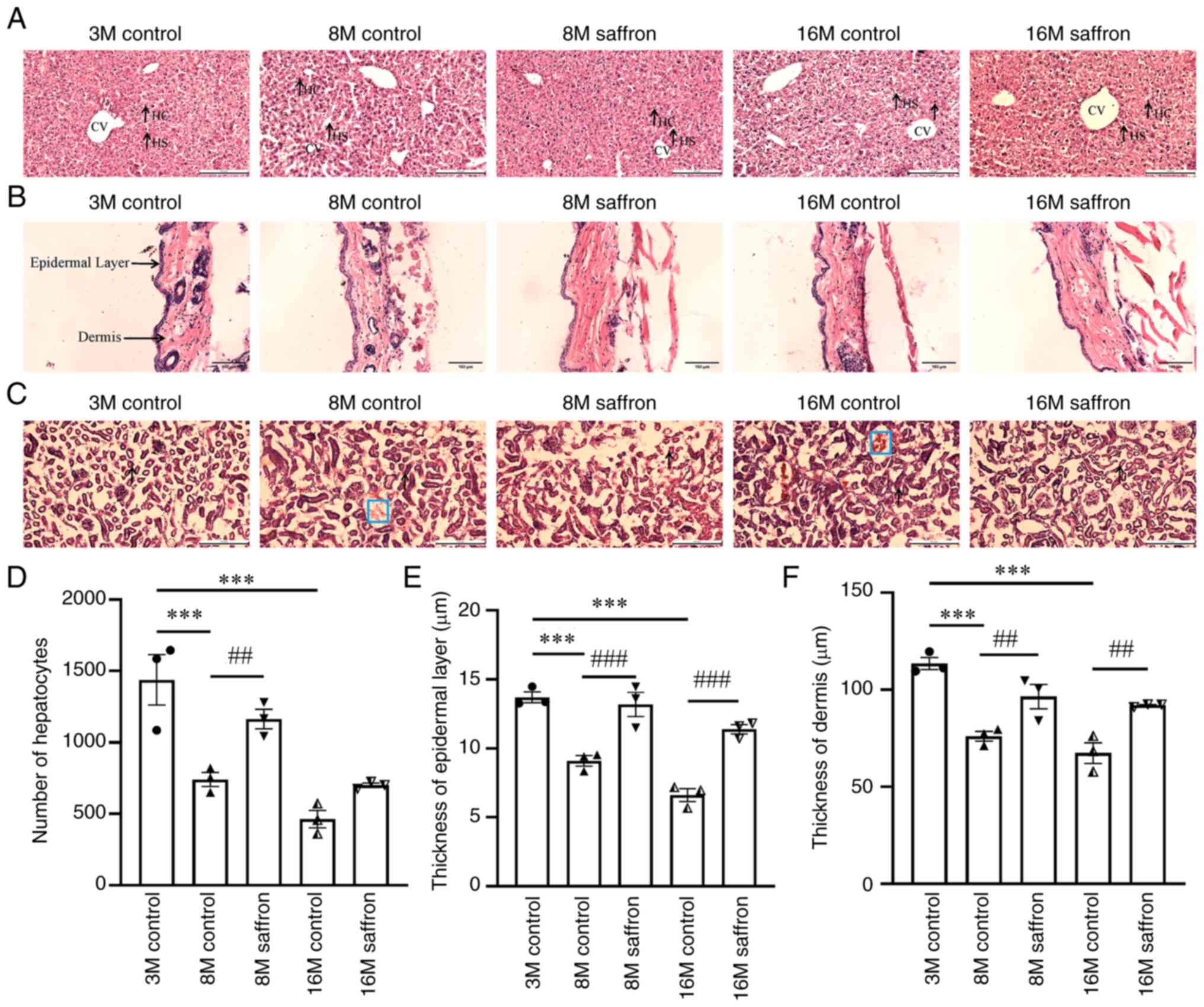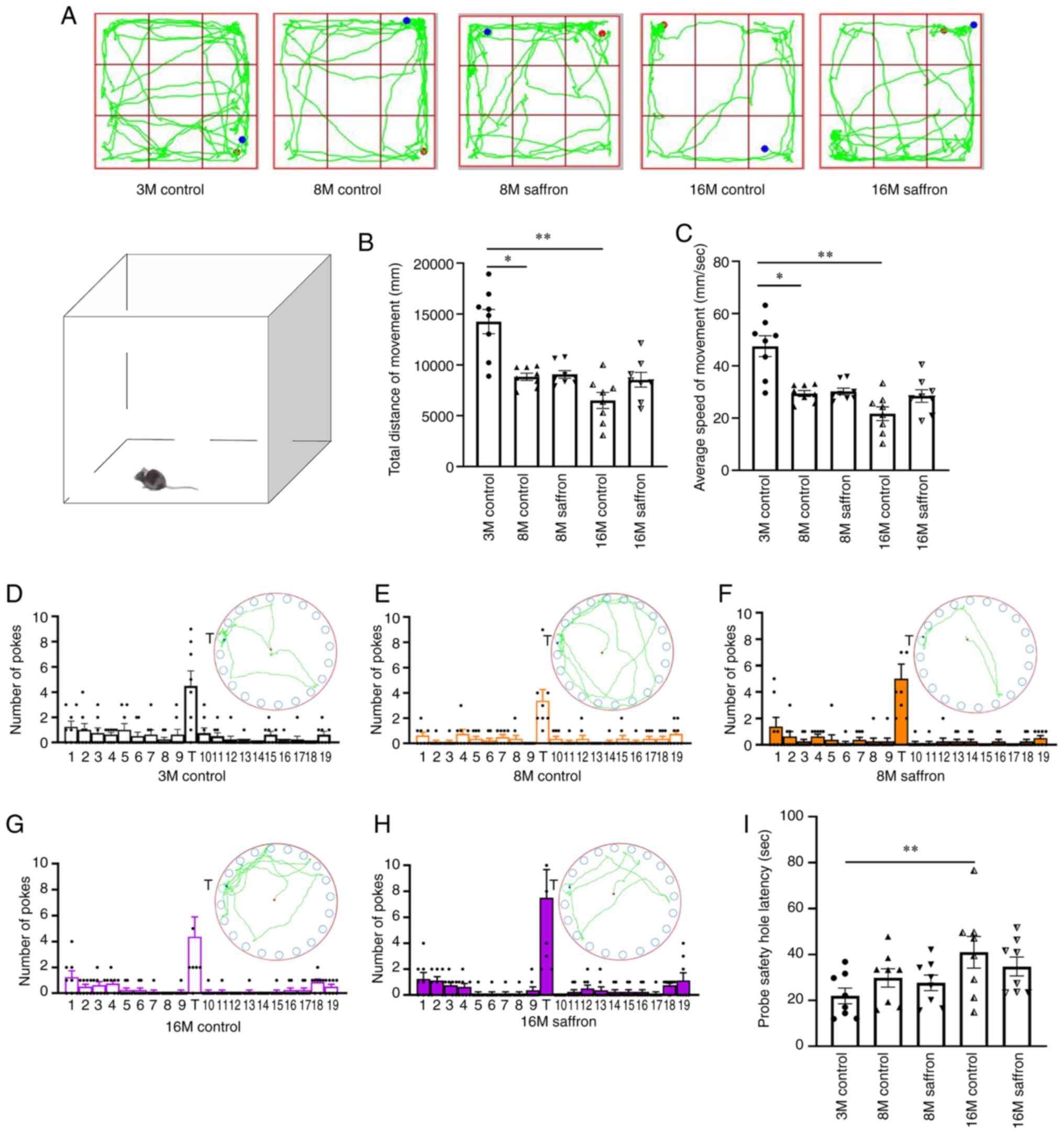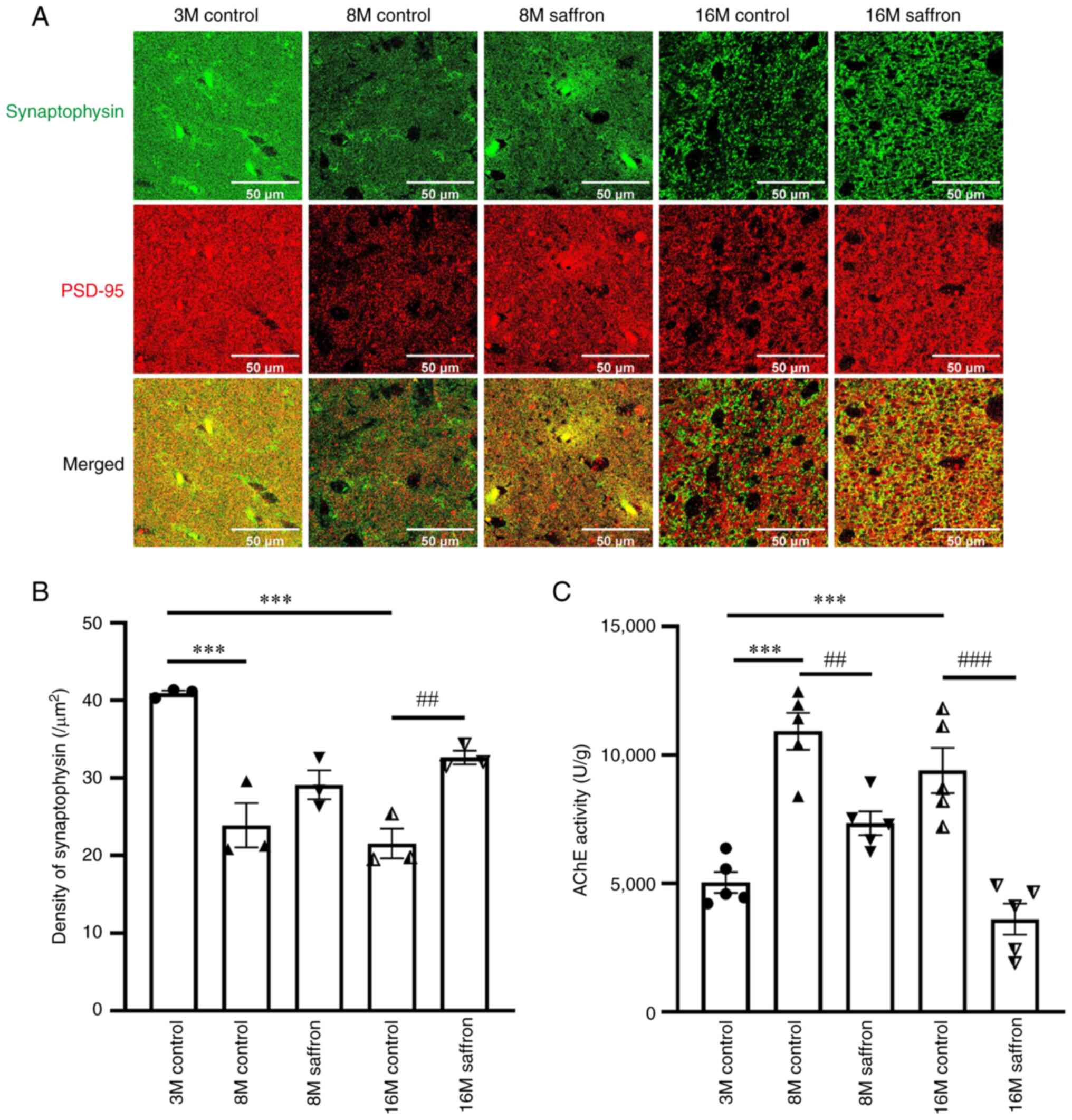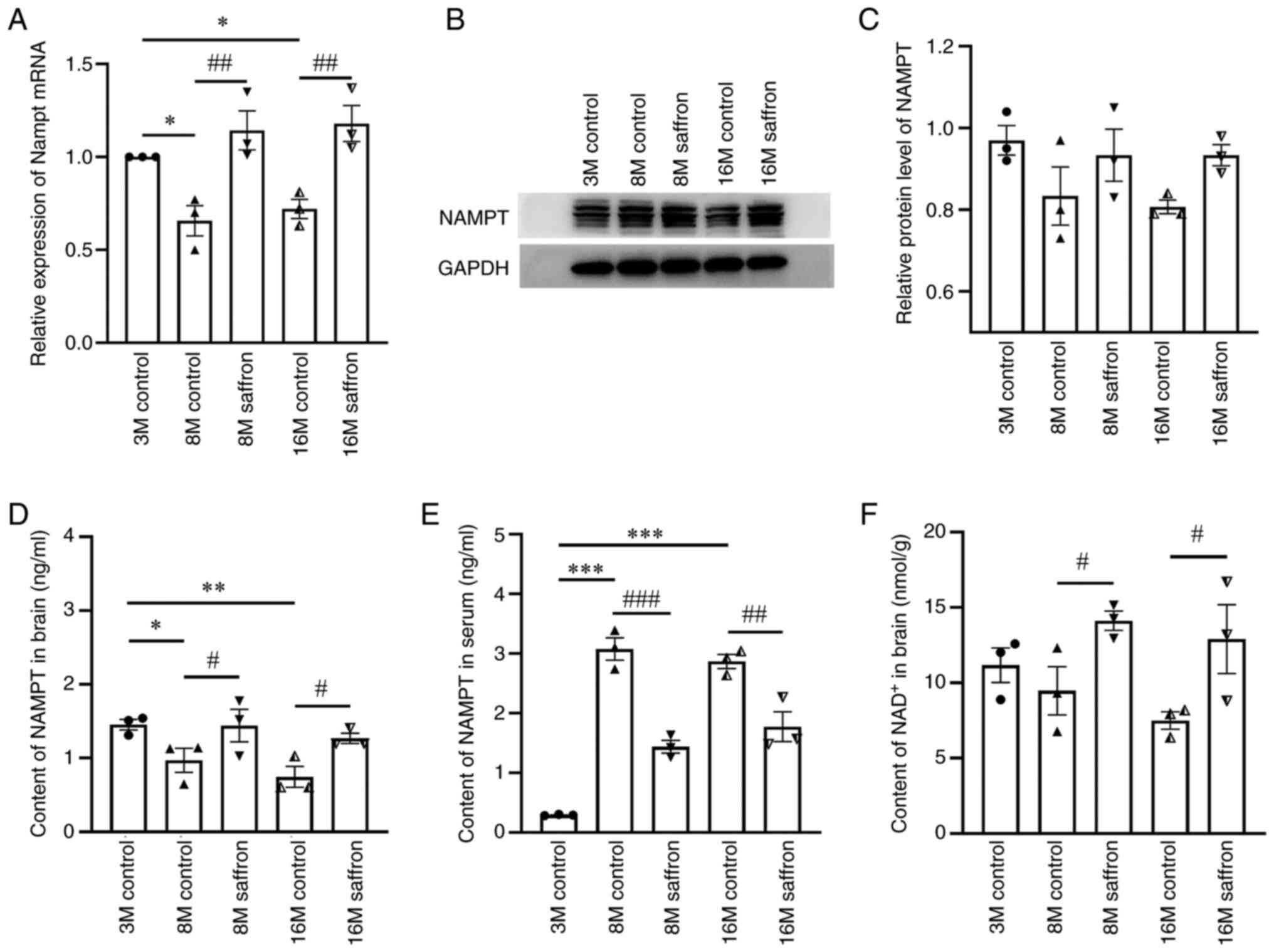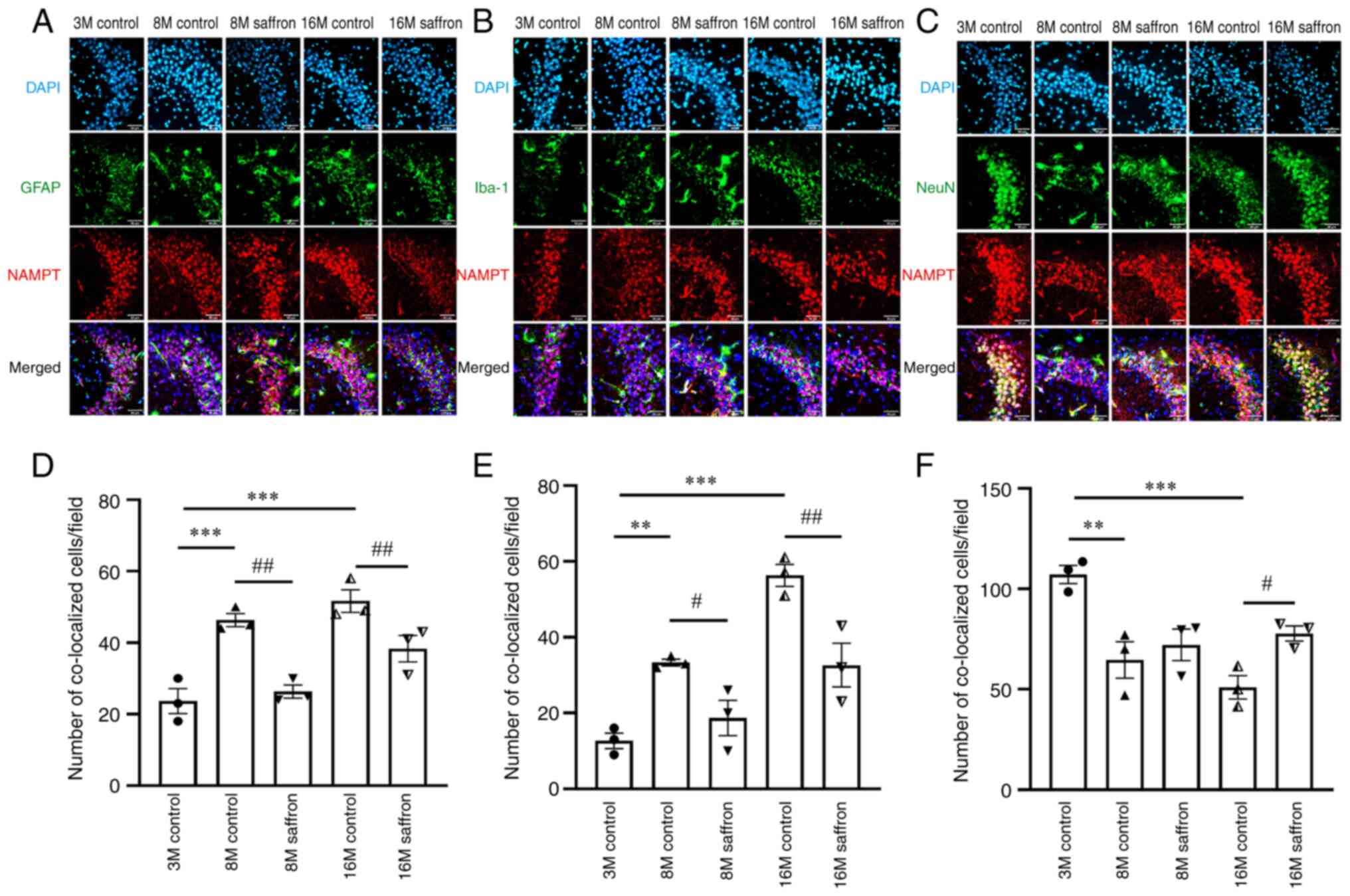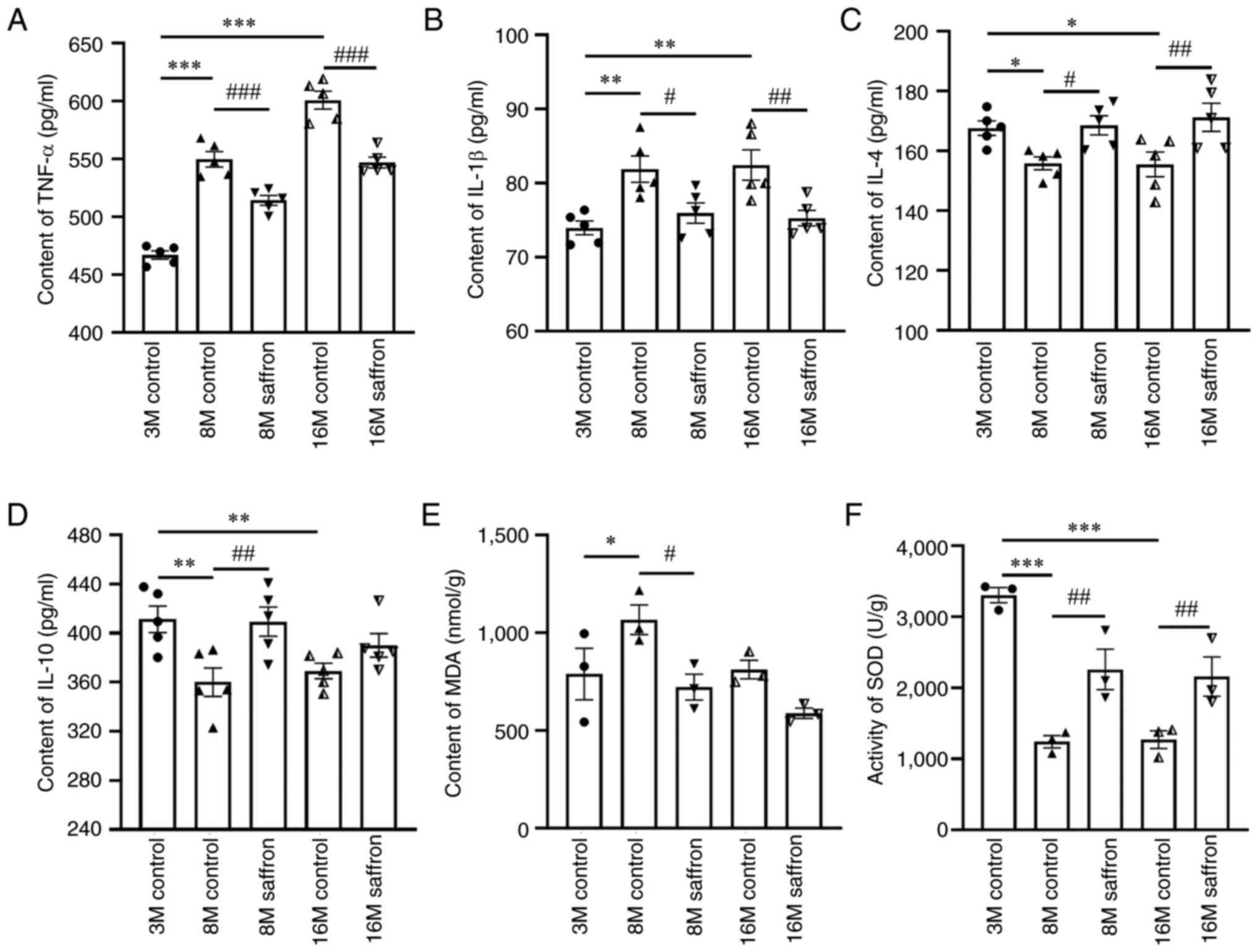|
1
|
Tchkonia T and Kirkland JL: Aging, cell
senescence, and chronic disease: Emerging therapeutic strategies.
JAMA. 320:1319–1320. 2018.PubMed/NCBI View Article : Google Scholar
|
|
2
|
Li X, Yang S, Wang S, Shi Y, Dai Y, Zhang
X, Liu Y, Guo Y, He J and Xiu M: Regulation and mechanism of
Astragalus polysaccharide on ameliorating aging in Drosophila
melanogaster. Int J Biol Macromol. 234(123632)2023.PubMed/NCBI View Article : Google Scholar
|
|
3
|
Lin K, Sze SC, Liu B, Zhang Z, Zhang Z,
Zhu P, Wang Y, Deng Q, Yung KK and Zhang S: 20(S)-protopanaxadiol
and oleanolic acid ameliorate cognitive deficits in APP/PS1
transgenic mice by enhancing hippocampal neurogenesis. J Ginseng
Res. 45:325–333. 2021.PubMed/NCBI View Article : Google Scholar
|
|
4
|
Bostan HB, Mehri S and Hosseinzadeh H:
Toxicology effects of saffron and its constituents: A review. Iran
J Basic Med Sci. 20:110–121. 2017.PubMed/NCBI View Article : Google Scholar
|
|
5
|
Jose Bagur M, Alonso Salinas GL,
Jimenez-Monreal AM, Chaouqi S, Llorens S, Martínez-Tomé M and
Alonso GL: Saffron: An old medicinal plant and a potential novel
functional food. Molecules. 23(30)2017.PubMed/NCBI View Article : Google Scholar
|
|
6
|
Tamegart L, Abbaoui A, Makbal R, Zroudi M,
Bouizgarne B, Bouyatas MM and Gamrani H: Crocus sativus restores
dopaminergic and noradrenergic damages induced by lead in Meriones
shawi: A possible link with Parkinson's disease. Acta Histochem.
121:171–181. 2019.PubMed/NCBI View Article : Google Scholar
|
|
7
|
Zhong K, Wang RX, Qian XD, Yu P, Zhu XY,
Zhang Q and Ye YL: Neuroprotective effects of saffron on the late
cerebral ischemia injury through inhibiting astrogliosis and glial
scar formation in rats. Biomed Pharmacother.
126(110041)2020.PubMed/NCBI View Article : Google Scholar
|
|
8
|
Khorasanchi Z, Shafiee M, Kermanshahi F,
Khazaei M, Ryzhikov M, Parizadeh MR, Kermanshahi B, Ferns GA, Avan
A and Hassanian SM: Crocus sativus a natural food coloring and
flavoring has potent anti-tumor properties. Phytomedicine.
43:21–27. 2018.PubMed/NCBI View Article : Google Scholar
|
|
9
|
Zhang F, Zhu X, Yu P, Sheng T, Wang Y and
Ye Y: Crocin ameliorates depressive-like behaviors induced by
chronic restraint stress via the NAMPT-NAD(+)-SIRT1 pathway in
mice. Neurochem Int. 157(105343)2022.PubMed/NCBI View Article : Google Scholar
|
|
10
|
Madan K and Nanda S: In-vitro evaluation
of antioxidant, anti-elastase, anti-collagenase, anti-hyaluronidase
activities of safranal and determination of its sun protection
factor in skin photoaging. Bioorg Chem. 77:159–167. 2018.PubMed/NCBI View Article : Google Scholar
|
|
11
|
Chalatsa I, Arvanitis DA, Koulakiotis NS,
Giagini A, Skaltsounis AL, Papadopoulou-Daifoti Z, Tsarbopoulos A
and Sanoudou D: The crocus sativus compounds trans-crocin 4 and
trans-crocetin modulate the amyloidogenic pathway and tau
misprocessing in alzheimer disease neuronal cell culture models.
Front Neurosci. 13(249)2019.PubMed/NCBI View Article : Google Scholar
|
|
12
|
Heidari S, Mehri S and Hosseinzadeh H:
Memory enhancement and protective effects of crocin against
D-galactose aging model in the hippocampus of Wistar rats. Iran J
Basic Med Sci. 20:1250–1259. 2017.PubMed/NCBI View Article : Google Scholar
|
|
13
|
Koltai E, Szabo Z, Atalay M, Boldogh I,
Naito H, Goto S, Nyakas C and Radak Z: Exercise alters SIRT1,
SIRT6, NAD and NAMPT levels in skeletal muscle of aged rats. Mech
Ageing Dev. 131:21–28. 2010.PubMed/NCBI View Article : Google Scholar
|
|
14
|
Sun Z, Lei H and Zhang Z: Pre-B cell
colony enhancing factor (PBEF), a cytokine with multiple
physiological functions. Cytokine Growth Factor Rev. 24:433–442.
2013.PubMed/NCBI View Article : Google Scholar
|
|
15
|
Liu LY, Wang F, Zhang XY, Huang P, Lu YB,
Wei EQ and Zhang WP: Nicotinamide phosphoribosyltransferase may be
involved in age-related brain diseases. PLoS One.
7(e44933)2012.PubMed/NCBI View Article : Google Scholar
|
|
16
|
Zhou H, Zhang Y, Hu S, Shi C, Zhu P, Ma Q,
Jin Q, Cao F, Tian F and Chen Y: Melatonin protects cardiac
microvasculature against ischemia/reperfusion injury via
suppression of mitochondrial fission-VDAC1-HK2-mPTP-mitophagy axis.
J Pineal Res. 63(e12413)2017.PubMed/NCBI View Article : Google Scholar
|
|
17
|
Garten A, Petzold S, Korner A, Imai S and
Kiess W: Nampt: Linking NAD biology, metabolism and cancer. Trends
Endocrinol Metab. 20:130–138. 2009.PubMed/NCBI View Article : Google Scholar
|
|
18
|
Imai S: The NAD World: A new systemic
regulatory network for metabolism and aging-Sirt1, systemic NAD
biosynthesis, and their importance. Cell Biochem Biophys. 53:65–74.
2009.PubMed/NCBI View Article : Google Scholar
|
|
19
|
Wang F and Zhang WP: Research progress on
nicotinamide phosphoribosyl transferase involved in aging and
age-related diseases. Zhejiang Da Xue Xue Bao Yi Xue Ban.
40:680–684. 2011.PubMed/NCBI View Article : Google Scholar : (In Chinese).
|
|
20
|
Moshfegh F, Balanejad SZ, Shahrokhabady K
and Attaranzadeh A: Crocus sativus (saffron) petals extract and its
active ingredient, anthocyanin improves ovarian dysfunction,
regulation of inflammatory genes and antioxidant factors in
testosterone-induced PCOS mice. J Ethnopharmacol.
282(114594)2022.PubMed/NCBI View Article : Google Scholar
|
|
21
|
Livak KJ and Schmittgen TD: Analysis of
relative gene expression data using real-time quantitative PCR and
the 2(-Delta Delta C(T)) Method. Methods. 25:402–408.
2001.PubMed/NCBI View Article : Google Scholar
|
|
22
|
Okabe S, Miwa A and Okado H: Spine
formation and correlated assembly of presynaptic and postsynaptic
molecules. J Neurosci. 21:6105–6114. 2001.PubMed/NCBI View Article : Google Scholar
|
|
23
|
Ibrayeva A, Bay M, Pu E, Jörg DJ, Peng L,
Jun H, Zhang N, Aaron D, Lin C, Resler G, et al: Early stem cell
aging in the mature brain. Cell Stem Cell. 28:955–966 e7.
2021.PubMed/NCBI View Article : Google Scholar
|
|
24
|
Alavizadeh SH and Hosseinzadeh H:
Bioactivity assessment and toxicity of crocin: A comprehensive
review. Food Chem Toxicol. 64:65–80. 2014.PubMed/NCBI View Article : Google Scholar
|
|
25
|
Hosseini A, Razavi BM and Hosseinzadeh H:
Pharmacokinetic properties of saffron and its active components.
Eur J Drug Metab Pharmacokinet. 43:383–390. 2018.PubMed/NCBI View Article : Google Scholar
|
|
26
|
El-Sherbiny M, Atef H, Helal GM, Al-Serwi
RH, Elkattawy HA, Shaker GA, Said E, Abulfaraj M, Albalawi MA and
Elsherbiny NM: Vitamin K2 (MK-7) Intercepts Keap-1/Nrf-2/HO-1
pathway and hinders inflammatory/apoptotic signaling and liver
aging in naturally aging rat. Antioxidants (Basel).
11(2150)2022.PubMed/NCBI View Article : Google Scholar
|
|
27
|
Dybiec J, Szlagor M, Mlynarska E, Rysz J
and Franczyk B: Structural and functional changes in aging kidneys.
Int J Mol Sci. 23(15435)2022.PubMed/NCBI View Article : Google Scholar
|
|
28
|
Lee H, Hong Y and Kim M: Structural and
functional changes and possible molecular mechanisms in aged skin.
Int J Mol Sci. 22(12489)2021.PubMed/NCBI View Article : Google Scholar
|
|
29
|
Logan S, Owen D, Chen S, Chen WJ, Ungvari
Z, Farley J, Csiszar A, Sharpe A, Loos M, Koopmans B, et al:
Simultaneous assessment of cognitive function, circadian rhythm,
and spontaneous activity in aging mice. Geroscience. 40:123–137.
2018.PubMed/NCBI View Article : Google Scholar
|
|
30
|
Creighton SD, Stefanelli G, Reda A and
Zovkic IB: Epigenetic mechanisms of learning and memory:
Implications for aging. Int J Mol Sci. 21(6918)2020.PubMed/NCBI View Article : Google Scholar
|
|
31
|
Shoji H and Miyakawa T: Age-related
behavioral changes from young to old age in male mice of a C57BL/6J
strain maintained under a genetic stability program.
Neuropsychopharmacol Rep. 39:100–118. 2019.PubMed/NCBI View Article : Google Scholar
|
|
32
|
Liu B, Kou J, Li F, Huo D, Xu J, Zhou X,
Meng D, Ghulam M, Artyom B, Gao X, et al: Lemon essential oil
ameliorates age-associated cognitive dysfunction via modulating
hippocampal synaptic density and inhibiting acetylcholinesterase.
Aging (Albany NY). 12:8622–8639. 2020.PubMed/NCBI View Article : Google Scholar
|
|
33
|
Alonso-Nanclares L, Merino-Serrais P,
Gonzalez S and DeFelipe J: Synaptic changes in the dentate gyrus of
APP/PS1 transgenic mice revealed by electron microscopy. J
Neuropathol Exp Neurol. 72:386–395. 2013.PubMed/NCBI View Article : Google Scholar
|
|
34
|
Wan L, Ai JQ, Yang C, Jiang J, Zhang QL,
Luo ZH, Huang RJ, Tu T, Pan A, Tu E, et al: Expression of the
excitatory postsynaptic scaffolding protein, shank3, in human
brain: effect of age and alzheimer's disease. Front Aging Neurosci.
13(717263)2021.PubMed/NCBI View Article : Google Scholar
|
|
35
|
Chandar NB and Ganguly B: A first
principles investigation of aging processes in soman conjugated
AChE. Chem Biol Interact. 204:185–190. 2013.PubMed/NCBI View Article : Google Scholar
|
|
36
|
Stromland O, Diab J, Ferrario E, Sverkeli
LJ and Ziegler M: The balance between NAD(+) biosynthesis and
consumption in ageing. Mech Ageing Dev. 199(111569)2021.PubMed/NCBI View Article : Google Scholar
|
|
37
|
Garten A, Schuster S, Penke M, Gorski T,
de Giorgis T and Kiess W: Physiological and pathophysiological
roles of NAMPT and NAD metabolism. Nat Rev Endocrinol. 11:535–546.
2015.PubMed/NCBI View Article : Google Scholar
|
|
38
|
van der Veer E, Ho C, O'Neil C, Barbosa N,
Scott R, Cregan SP and Pickering JG: Extension of human cell
lifespan by nicotinamide phosphoribosyltransferase. J Biol Chem.
282:10841–10845. 2007.PubMed/NCBI View Article : Google Scholar
|
|
39
|
Yang H, Yang T, Baur JA, Perez E, Matsui
T, Carmona JJ, Lamming DW, Souza-Pinto NC, Bohr VA, Rosenzweig A,
et al: Nutrient-sensitive mitochondrial NAD+ levels dictate cell
survival. Cell. 130:1095–1107. 2007.PubMed/NCBI View Article : Google Scholar
|
|
40
|
Revollo JR, Korner A, Mills KF, Satoh A,
Wang T, Garten A, Dasgupta B, Sasaki Y, Wolberger C, Townsend RR,
et al: Nampt/PBEF/Visfatin regulates insulin secretion in beta
cells as a systemic NAD biosynthetic enzyme. Cell Metab. 6:363–375.
2007.PubMed/NCBI View Article : Google Scholar
|
|
41
|
Wang T, Zhang X, Bheda P, Revollo JR, Imai
S and Wolberger C: Structure of Nampt/PBEF/visfatin, a mammalian
NAD+ biosynthetic enzyme. Nat Struct Mol Biol. 13:661–662.
2006.PubMed/NCBI View Article : Google Scholar
|
|
42
|
Ma C, Pi C, Yang Y, Lin L, Shi Y, Li Y, Li
Y and He X: Nampt expression decreases age-related senescence in
rat bone marrow mesenchymal stem cells by targeting Sirt1. PLoS
One. 12(e0170930)2017.PubMed/NCBI View Article : Google Scholar
|
|
43
|
Xie X, Gao Y, Zeng M, Wang Y, Wei TF, Lu
YB and Zhang WP: Nicotinamide ribose ameliorates cognitive
impairment of aged and Alzheimer's disease model mice. Metab Brain
Dis. 34:353–366. 2019.PubMed/NCBI View Article : Google Scholar
|
|
44
|
Jurgens HA and Johnson RW: Dysregulated
neuronal-microglial cross-talk during aging, stress and
inflammation. Exp Neurol. 233:40–48. 2012.PubMed/NCBI View Article : Google Scholar
|
|
45
|
Bermudez B, Dahl TB, Medina I, Groeneweg
M, Holm S, Montserrat-de la Paz S, Rousch M, Otten J, Herias V,
Varela LM, et al: Leukocyte overexpression of intracellular NAMPT
attenuates atherosclerosis by regulating PPARү-Dependent monocyte
differentiation and function. Arterioscler Thromb Vasc Biol.
37:1157–1167. 2017.PubMed/NCBI View Article : Google Scholar
|
|
46
|
Kudryavtseva AV, Krasnov GS, Dmitriev AA,
Alekseev BY, Kardymon OL, Sadritdinova AF, Fedorova MS, Pokrovsky
AV, Melnikova NV, Kaprin AD, et al: Mitochondrial dysfunction and
oxidative stress in aging and cancer. Oncotarget. 7:44879–44905.
2016.PubMed/NCBI View Article : Google Scholar
|
|
47
|
Pawelec G: Aging as an inflammatory
disease and possible reversal strategies. J Allergy Clin Immunol.
145:1355–1356. 2020.PubMed/NCBI View Article : Google Scholar
|
|
48
|
Uyar B, Palmer D, Kowald A, Murua Escobar
H, Barrantes I, Möller S, Akalin A and Fuellen G: Single-cell
analyses of aging, inflammation and senescence. Ageing Res Rev.
64(101156)2020.PubMed/NCBI View Article : Google Scholar
|
|
49
|
Cerda-Bernad D, Valero-Cases E, Pastor JJ
and Frutos MJ: Saffron bioactives crocin, crocetin and safranal:
Effect on oxidative stress and mechanisms of action. Crit Rev Food
Sci Nutr. 62:3232–3249. 2022.PubMed/NCBI View Article : Google Scholar
|
|
50
|
Salem M, Shaheen M, Tabbara A and Borjac
J: Saffron extract and crocin exert anti-inflammatory and
anti-oxidative effects in a repetitive mild traumatic brain injury
mouse model. Sci Rep. 12(5004)2022.PubMed/NCBI View Article : Google Scholar
|
|
51
|
Wang J, Sun R, Xia L, Zhu X, Zhang Q and
Ye Y: Potential therapeutic effects of NAMPT-Mediated NAD
biosynthesis in depression in vivo. Brain Sci.
12(1699)2022.PubMed/NCBI View Article : Google Scholar
|
















